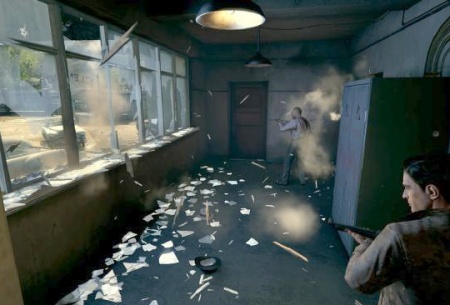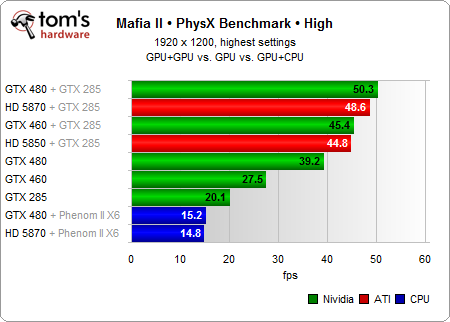Analysis: PhysX On Systems With AMD Graphics Cards
Rarely does an issue divide the gaming community like PhysX has. We go deep into explaining CPU- and GPU-based PhysX processing, run PhysX with a Radeon card from AMD, and put some of today's most misleading headlines about PhysX under our microscope.
GPU PhysX: Roundup: Free For All
Test Sequence and Combinations
We start by combining our test subjects and benchmarking them in the following configurations:
- AMD main graphics card + GPU PhysX (Nvidia card)
- Nvidia main graphics card + GPU PhysX (Nvidia card)
- A single graphics card running GPU-based PhysX
- CPU-based PhysX
Instead of using the games Metro 2033 and Cryostasis for benchmarks, we opted for the recently-published Mafia II. Its ratio of graphics to physics is quite balanced, and it allows us to make a direct reference to a current game so our recommendations are more relevant.
| OS | Windows 7 Ultimate x64 |
|---|---|
| Game | Mafia 2 via Steam |
| Version | Updated 08.09.2010 |
Below is the chart we created using the different combinations of graphics cards and manufacturers:
As expected, using a dedicated graphics card for PhysX makes a difference. Pairing it with a high-end model from each camp results in a rather even playfield. The GeForce GTX 480 can neither pull ahead much from the Radeon HD 5870, nor really make the GeForce GTX 460 and Radeon HD 5850 eat its dust. All of the GPU + GPU combinations are significantly faster than using just a single Nvidia card for both graphics and PhysX.
The single cards are already dangerously close to the lower limits of playability. The chart shows the average frame rates, but obviously the difference will be seen most clearly in minimum frame rate numbers. Most of the time you will be walking around, and the frame rates will be the same regardless of whether you are using a dedicated PhysX card or not. But as soon as something happens that requires physics calculations, that's where the difference lies. Since this happens only briefly and occasionally, we chose to show you the overall picture instead.
Get Tom's Hardware's best news and in-depth reviews, straight to your inbox.
Current page: GPU PhysX: Roundup: Free For All
Prev Page How To: His Majesty, Radeon The Fifth, And The PhysX Squire, GeForce Next Page GPU PhysX: What Card Is Best?
Igor Wallossek wrote a wide variety of hardware articles for Tom's Hardware, with a strong focus on technical analysis and in-depth reviews. His contributions have spanned a broad spectrum of PC components, including GPUs, CPUs, workstations, and PC builds. His insightful articles provide readers with detailed knowledge to make informed decisions in the ever-evolving tech landscape
-
eyefinity So it's basically what everybody in the know already knew - nVidia is holding back progress in order to line their own pockets.Reply -
Emperus Is it 'Physx by Nvidia' or 'Physx for Nvidia'..!! Its a pity to read those lines wherein it says that Nvidia is holding back performance when a non-Nvidia primary card is detected..Reply -
It looks like the increase in CPU utilization with CPU physX is only 154%, which could be 1 thread plus synchronization overhead with the main rendering threads.Reply
-
eyefinity The article could barely spell it out more clearly.Reply
Everyone could be enjoying cpu based Physics, making use of their otherwise idle cores.
The problem is, nVidia doesn't want that. They have a proprietary solution which slows down their own cards, and AMD cards even more, making theirs seem better. On top of that, they throw money at games devs so they don't include better cpu physics.
Everybody loses except nVidia. This is not unusual behaviour for them, they are doing it with Tesellation now too - slowing down their own cards because it slows down AMD cards even more, when there is a better solution that doesn't hurt anybody.
They are a pure scumbag company. -
rohitbaran In short, a good config to enjoy Physx requires selling an arm or a leg and the game developers and nVidia keep screwing the users to save their money and propagate their business interests respectively.Reply -
iam2thecrowe The world needs need opencl physics NOW! Also, while this is an informative article, it would be good to see what single nvidia cards make games using physx playable. Will a single gts450 cut it? probably not. That way budget gamers can make a more informed choice as its no point chosing nvidia for physx and finding it doesnt run well anyway on mid range cards so they could have just bought an ATI card and been better off.Reply -
archange Believe it or not, this morning I was determined to look into this same problem, since I just upgraded from an 8800 GTS 512 to an HD 6850. :OReply
Thank you, Tom's, thank you Igor Wallossek for makinng it easy!
You just made my day: a big thumbs up! -
jamesedgeuk2000 What about people with dedicated PPU's? I have 8800 GTX SLi and an Ageia Physx card where do I come into it?Reply -
skokie2 What is failed to be mentioned (and if what I see is real its much more predatory) that simply having an onboard AMD graphics, even if its disabled in the BIOS, stops PhysX working. This is simply outragous. My main hope is that AMD finally gets better at linux drivers so my next card does not need to be nVidia. I will vote with my feet... so long as there is another name on the slip :( Sad state of graphics generally and been getting worse since AMD bought ATI.. it was then that this game started... nVidia just takes it up a notch.Reply

